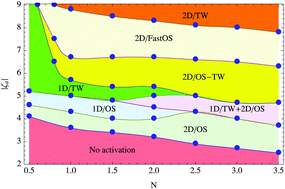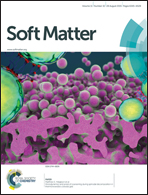Kinetic attractor phase diagrams of active nematic suspensions: the dilute regime
Abstract
Large-scale simulations by the authors of the kinetic-hydrodynamic equations for active polar nematics revealed a variety of spatio-temporal attractors, including steady and unsteady, banded (1d) and cellular (2d) spatial patterns. These particle scale activation-induced attractors arise at dilute nanorod volume fractions where the passive equilibrium phase is isotropic, whereas all previous model simulations have focused on the semi-dilute, nematic equilibrium regime and mostly on low-moment orientation tensor and polarity vector models. Here we extend our previous results to complete attractor phase diagrams for active nematics, with and without an explicit polar potential, to map out novel spatial and dynamic transitions, and to identify some new attractors, over the parameter space of dilute nanorod volume fraction and nanorod activation strength. The particle-scale activation parameter corresponds experimentally to a tunable force dipole strength (so-called pushers with propulsion from the rod tail) generated by active rod macromolecules, e.g., catalysis with the solvent phase, ATP-induced propulsion, or light-activated propulsion. The simulations allow 2d spatial variations in all flow and orientational variables and full spherical orientational degrees of freedom; the attractors correspond to numerical integration of a coupled system of 125 nonlinear PDEs in 2d plus time. The phase diagrams with and without the polar interaction potential are remarkably similar, implying that polar interactions among the rodlike particles are not essential to long-range spatial and temporal correlations in flow, polarity, and nematic order. As a general rule, above a threshold, low volume fractions induce 1d banded patterns, whereas higher yet still dilute volume fractions yield 2d patterns. Again as a general rule, varying activation strength at fixed volume fraction induces novel dynamic transitions. First, stationary patterns saturate the instability of the isotropic state, consisting of discrete 1d banded or 2d cellular patterns depending on nanorod volume fraction. Increasing activation strength further induces a sequence of attractor bifurcations, including oscillations superimposed on the 1d and 2d stationary patterns, a uniform translational motion of 1d and 2d oscillating patterns, and periodic switching between 1d and 2d patterns. These results imply that active macromolecular suspensions are capable of long-range spatial and dynamic organization at isotropic equilibrium concentrations, provided particle-scale activation is sufficiently strong.


 Please wait while we load your content...
Please wait while we load your content...